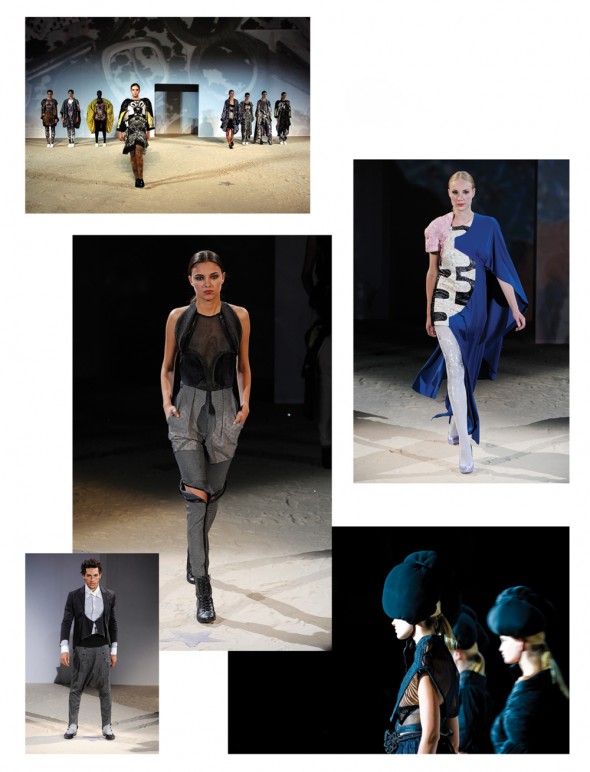
Trieste is a small town nested on an eponymous gulf in northeastern Italy. Of Austro-Hungarian splendor, it is today a quiet, cultural pole of students and senior citizens. But once a year, the fashion pack descends on the quiet town in search of new talent. They are here for ITS, a competition that has single-handedly revolutionized the fashion world. Hailing from the small Italian town, the PR agency EVE has gathered an outstanding list of names to make the dreams of founder Barbara Franchin possible. These dreams include discovering, promoting and nurturing the best new talent from all over the world, and after eight years since its inception, her dreams have evolved into a huge event followed by the world’s most important press and supported by some of the biggest names in fashion and communication today.
Expanded from a fashion-only competition to a multi-disciplinary affair of fashion, accessories and photography, ITS is now widely recognized for discovering the future names of fashion. Notable alumni include print master Peter Pilotto, Mark Fast and his revolutionary knitwear, and Natalia Brilli’s controversial accessories. With Diesel’s Renzo Rosso as the main partner and head of the international jury, and with the support of YKK, MINI and many local and international institutions, ITS has scoured the world’s most illustrious schools and academies to find graduates worthy of international exposure and prizes. This year, SOMA traveled to Trieste to discover the best of the best, courtesy of ITS.
Erika Comin
Space, time and ancient traditions merge in the work of the only Italian-born and educated contestant this year. Hailing from Venice, where she just graduated with a BA in Fashion Design from IUAV, Erika Comin looked east when designing her collection, inspired by the Miao people of Southern China. The rich clothing culture of the Asian population fascinated the 22-year-old so much that it inspired her to create a timeless style of black pleated silk and intricate yarn structures, complemented by Chinese headpieces and shoes. The totally black palette concealed the extreme workmanship of each garment, encouraging a closer look at this carefully folded and knotted set of pieces.
Alice Knackfuss
Winner of the prestigious Diesel Prize, the Munich-born designer’s menswear ensembles fused a mature attire with the playful pattern-matching of childrenswear, identifying “the conflict between adapting to society rules and living out someone’s individual needs.” The finished product of this seemingly irrational combination was a strong, highly wearable set of coats, shorts and jackets. Perfectly executed outerwear was the focus, inspired by Victorian apparel but still contemporary. The urban collection perfectly summarized her question: “Is it better to be an individual personality living the innocent values of a child or somebody who agrees with standards and rules?”
Johanne Kappel Andersen
Johanne Kappel Andersen once found a newspaper article with the headline: “Boy raised like a bird by his mother.” The mix of fascination and horror the story produced inspired the Dutch designer’s collections. She narrated a new tale, imagining what it would be like to be raised as a magpie; her jersey pieces featured abstract prints of small treasures. The Royal College of Art graduate created a collection that hugged and complemented the body, with pastel hues and subtle grays floating on light coats and small everyday objects on soft minidresses.
Saara Lepokorpi
Light fabrics, pastel colors and strong structures were the set of simple yet powerful pieces by the Finnish designer, Saara Lepokorpi. Inspired by moths, Lepokorpi translated the insect into stark lines and muted palettes. Images of the insect were used in patterns and prints, and the silhouettes were referenced for the shape of the clothing. With a universal feminine body in mind, Lepokorpi’s designs span adaptable sizes and shapes.
Michael Van Der Ham
Nonsense pairings of different couture eras are the essence of Van Der Ham’s graduate collection. One of the most interesting catwalk moments seen at London Fashion Week’s Central Saint Martin’s show, his eclectic couplings won him the Vertice Award, for which his designs will be on show at the Turin boutique. Taking cues from a Diana Vreeland-curated exhibition of Andy Warhol’s dresses, the Dutch designer challenged himself to create harmony from a clash of eras, resulting finally in a stunning set of dresses.
Clockwise from left:
Johanne Kappel Andersen,
Michael Van Der Ham,
Erika Comin,
Alice Knackfuss,
and Saara Lepokorpi.
– Rosa Maria Bertoli
Photography by Giovanni Giannoni

